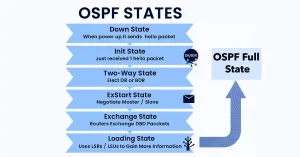OSPF Router States and OSPF Process Explained
When an OSPF router is first connected to a network, it follows a link-state routing process to achieve convergence. This involves building adjacencies, exchanging information, and progressing through various neighbor states. We’ll start with the overall OSPF process before diving into the states. OSPF Process Overview Step 1: Create Adjacencies with Neighbors An OSPF-configured router […]

